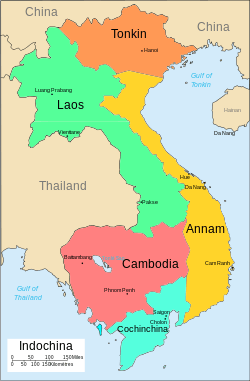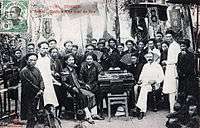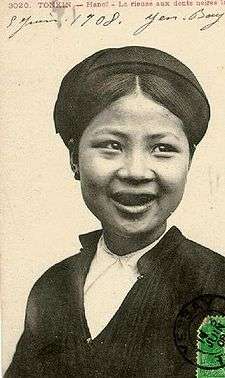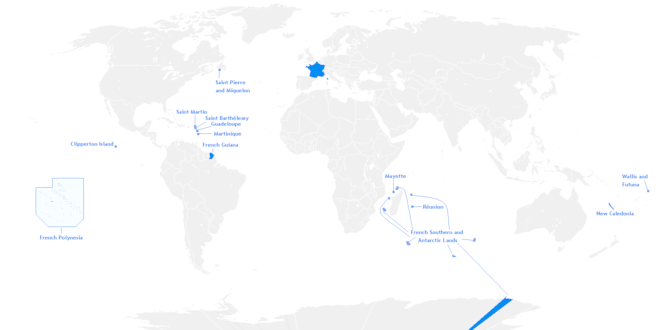Tonkin (French protectorate)
| Protectorate of Tonkin Protectorat du Tonkin | |||||||||||||||||
|---|---|---|---|---|---|---|---|---|---|---|---|---|---|---|---|---|---|
|
1883–1945 1945–1948 | |||||||||||||||||
 .svg.png) Flag | |||||||||||||||||
 Tonkin was located in present-day northern Vietnam, shaded orange | |||||||||||||||||
| Status | Protectorate of France; constituent territory of French Indochina | ||||||||||||||||
| Capital | Ha Noi | ||||||||||||||||
| Common languages | French, Vietnamese, Central Tai languages, Southwestern Tai languages, Hmongic languages, Mienic languages | ||||||||||||||||
| Religion | Mahayana Buddhism, Confucianism | ||||||||||||||||
| Historical era | New Imperialism | ||||||||||||||||
• Established | 1883 | ||||||||||||||||
• Disestablished | 1948 | ||||||||||||||||
| Currency |
Vietnamese cash, French Indochinese piastre | ||||||||||||||||
| |||||||||||||||||
| Today part of |
| ||||||||||||||||
Tonkin, or Bắc Kỳ (北圻), was a French protectorate encompassing modern Northern Vietnam.
Establishment
After helping to unify Vietnam under the Nguyen Dynasty, the French Navy began its heavy presence in the Mekong Delta and later colonised the southern third of Vietnam including Saigon in 1867. Central Vietnam later became the French protectorate of Annam and French influence in the Indochina Peninsula strengthened. During the Sino-French War (1884–85), the northernmost part of Vietnam, Tonkin (then considered a crucial foothold in Southeast Asia and a key to the Chinese market) was invaded by the French. After the Treaty of Tientsin, all of Vietnam was governed by the French.
During the French colonial administration, Vietnam was administratively divided into three different territories: Tonkin (in the north), Annam (in the centre), and the colony of Cochinchina (in the south). These territories were fairly arbitrary in their geographic extent as the vast majority of the Vietnamese regarded their country as a single land and minor resistance to French rule continued over the next 70 years to achieve an independent state. Annam and Tonkin were originally a single entity, the Résidence supérieure of Annam-Tonkin. On June 3, 1886, the Nguyễn Emperor Đồng Khánh delegated all of his powers in Tonkin to a Kinh luoc su (equivalent of Viceroy), who acted under French supervision. On May 9, 1889, the Résidence supérieure of Annam-Tonkin was abolished, with Annam and Tonkin being separated in two Résidences supérieures, each subordinated to the Governor-General of French Indochina. On July 26, 1897, Governor-General Paul Doumer had Emperor Thành Thái abolish the post of Kinh luoc su. Also the Nguyễn dynasty still nominally reigned over Tonkin, it was now de facto under direct French rule.[1]
During French rule, Hanoi was made capital of Tonkin and, in 1901, of the whole French Indochina. Cities in Tonkin saw significant infrastructure and economic development under the French, such as the development of the port of Haiphong and construction of the Trans-Indochinois Railway linking Hanoi to Saigon. Under French economic plans, mines yielding gold, silver, and tin as well as the farming of rice, corn, and tea powered Tonkin's economy. The imports included rice, iron goods, flour, wine, opium and cotton goods. Industrialization later led to the opening of factories producing textiles and china for export throughout the French Empire. French cultural influence on Tonkin was also significant as French became the primary language of education, government, trade and media and heavy Catholic missionary activity resulted in almost 10% of the population identifying as Catholic by the 1940s. Prominent buildings in Hanoi were also constructed during the period of French rule, such as the Hanoi Opera House and the Hanoi University of Technology. By 1940, the total population of Annam was estimated at around 8 million.[2]
Administration
Tonkin was a component of French Indochina. It was a de facto French colony despite being a protectorate on paper. The British Naval Intelligence Division wrote during World War II that "at first the native political organization was maintained, but in 1897 the office of viceroy, representing the king of Annam in Tonkin, was abolished, and since then other changes have further weakened the influence of the native government."[3] Tonkin was administered by a French resident similar to those in Annam, Laos, and Cambodia, but he had much greater authority because of the absence of any indigenous administration.[3] A conseil du protectorat composed of important officials and representatives from the chambers of agriculture and commerce, assisted the resident in performing his duties. There was also an advisory council made up of Vietnamese.[3]
Tonkin was made up of 23 provinces, subdivided into phu or huyen, cantons, and communes.[3] Local administration was in the hands of Vietnamese mandarins, although they were appointed by the resident rather than the emperor as in Annam.[3] The smallest unit of administration, the commune, was overseen by two councils: the toc bieu, and the mandarin-dominated ky muc with the authority to veto decisions of the toc bieu.[3] Hanoi and Haiphong had municipal councils appointed by the governor-general of Indochina.[3]
End
French colonial administration lasted until March 9, 1945, during Japanese occupation (1941–1945). Although French administration was allowed during Japanese occupation as a puppet government, Japan briefly took full control of Vietnam in March 1945 under the Empire of Vietnam and Tonkin became the site of the Vietnamese Famine of 1945 during this period.[4] At the end of the war, the north of Vietnam (including Tonkin) saw a sphere of influence by China while the south was briefly occupied by the British for French forces to regroup and regain control. Harry Truman at the Potsdam Conference, stated an intention to hand the region back to French rule, a sharp contrast to Franklin D. Roosevelt's strong opposition to colonialism and commitment to support the Viet Minh. However, after the Japanese withdrew from Vietnam, Ho Chi Minh proclaimed the establishment of the Democratic Republic of Vietnam in Ba Đình Square. Hanoi was later reoccupied by the French and conflict between the Viet Minh and France broke out into the First Indochina War.
As the French sought to establish a coherent government in Vietnam as an alternative to Ho Chi Minh, Tonkin was merged in 1948 into the Provisional Central Government of Vietnam, which was replaced the next year by the State of Vietnam, following the reunification with Cochinchina. After the French defeat at the Battle of Dien Bien Phu in Western Tonkin in 1954, the Communist state of North Vietnam was formed, consisting of Tonkin and northern Annam.
Gallery
 Capture of Nam Định, 1883
Capture of Nam Định, 1883 French zouave officer in Tonkin, Spring 1885
French zouave officer in Tonkin, Spring 1885 In Hanoi, around 1910
In Hanoi, around 1910 French General Gouvernor's Palace in Hanoi
French General Gouvernor's Palace in Hanoi Tonkin woman with black-painted teeth (ca. 1905)
Tonkin woman with black-painted teeth (ca. 1905)
See also
Notes
- ↑ Pierre Brocheux and Daniel Hémery, Indochine : la colonisation ambiguë 1858–1954, La Découverte, 2004, p. 78-81
- ↑ Le Vietnam compte à lui seul cinquante quatre ethnies, présentées au Musée Ethnographique de Hanoi.
- 1 2 3 4 5 6 7 Naval Intelligence Division, 203–204.
- ↑ L'Indochine française pendant la Seconde Guerre mondiale Archived February 5, 2012, at the Wayback Machine., Jean-Philippe Liardet
External links
![]()
Coordinates: 21°00′00″N 106°00′00″E / 21.0000°N 106.0000°E
